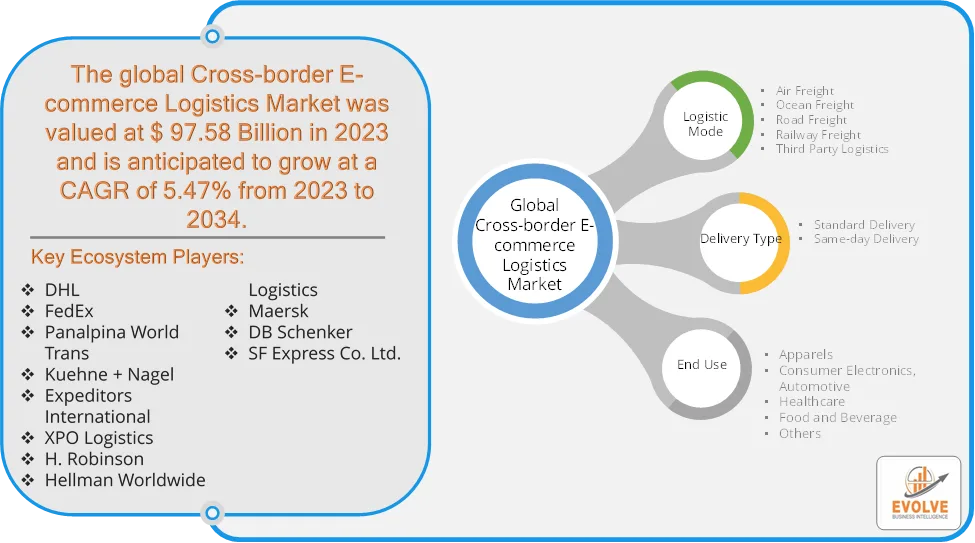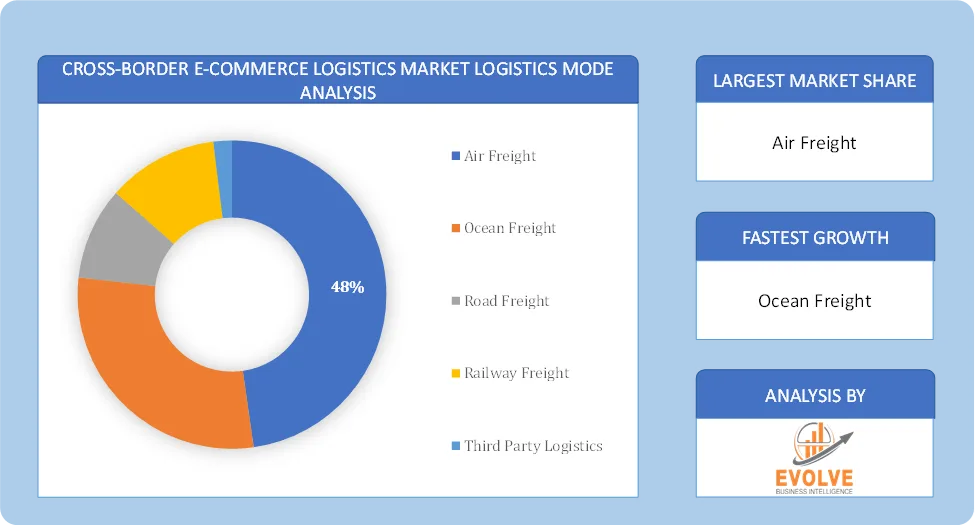Cross-border E-commerce Logistics Market to Reach USD 112.65 Billion by 2034

Evolve Business Intelligence has published a research report on the Global Cross-border E-commerce Logistics Market, 2024–2034. The global Cross-border E-commerce Logistics Market is projected to exhibit a CAGR of around 5.47% during the forecast period of 2024 to 2034.
Evolve Business Intelligence has recognized the following companies as the key players in the global Cross-border E-commerce Logistics Market: DHL, FedEx, Panalpina World Trans, Kuehne + Nagel, Expeditors International, XPO Logistics, H. Robinson, Hellman Worldwide Logistics, Maersk, DB Schenker and SF Express Co. Ltd.
The Global Cross-border E-commerce Logistics Market is projected to be valued at USD 112.65 Billion by 2034, recording a CAGR of around 5.47% during the forecast period. The cross-border e-commerce logistics market is experiencing significant growth, driven by the increasing popularity of online shopping and the desire of consumers to access a wider range of products from international markets. This necessitates sophisticated logistics networks to manage the complexities of international shipments, including transportation, warehousing, customs clearance, and last-mile delivery.
The cross-border e-commerce logistics market is dynamic and continues to evolve rapidly. Businesses that can effectively navigate the complexities and leverage emerging trends will be well-positioned to capitalize on the significant growth opportunities in this global marketplace.
Download the full report now to discover market trends, opportunities, and strategies for success.
Segmental Analysis
The global Cross-border E-commerce Logistics Market has been segmented based on Logistic Mode, Delivery Type and End Use.
Based on Logistic Mode, the Cross-border E-commerce Logistics Market is segmented into Air Freight, Ocean Freight, Road Freight, Railway Freight, Third Party Logistics. The Ocean Freight is anticipated to dominate the market.
Based on Delivery Type, the global Cross-border E-commerce Logistics Market has been segmented into Standard Delivery, Same-day Delivery. The Standard Delivery segment is anticipated to dominate the market.
Based on End Use, the global Cross-border E-commerce Logistics Market has been divided into Apparels, Consumer Electronics, Automotive, Healthcare, Food and Beverage, Others. The Apparels segment is anticipated to dominate the market.
Regional Analysis
The Cross-border E-commerce Logistics Market is divided into five regions: North America, Europe, Asia-Pacific, South America, and the Middle East, & Africa. North America currently holds a significant market share. The headquarters of global e-commerce giants like Amazon and eBay in North America contribute significantly to cross-border trade and logistics activities. The region boasts a well-established and advanced logistics infrastructure, facilitating efficient cross-border transportation and delivery. European countries generally have high disposable incomes and a strong propensity for online shopping. European consumers often seek out specialized or higher-quality goods from other European countries and beyond and the region has a mature e-commerce market with a wide range of online retailers and marketplaces catering to cross-border demand. In Asia-Pacific region, China as the world’s largest e-commerce market, China is a major driver of cross-border logistics in the region, with significant import and export volumes and With a rapidly growing internet user base and increasing adoption of online shopping, India presents a substantial growth opportunity for cross-border e-commerce logistics. Growing economic prosperity, particularly in countries like China and India, increases consumers’ purchasing power and their willingness to buy international goods. Latin America is a smaller but rapidly growing market for cross-border e-commerce logistics. A growing number of people in the region are gaining access to the internet and participating in online shopping and expanding middle-class incomes are driving demand for a wider variety of goods, including those sourced internationally. The MEA region represents a smaller portion of the global cross-border e-commerce logistics market but is showing promising growth. A significant proportion of the population in the Middle East is young and actively engaged in online activities, including e-commerce and Countries in the Gulf Cooperation Council (GCC) have high per capita incomes, driving demand for international luxury goods and other products.



